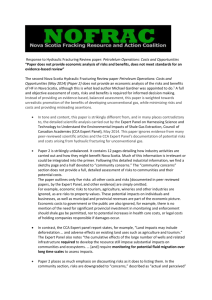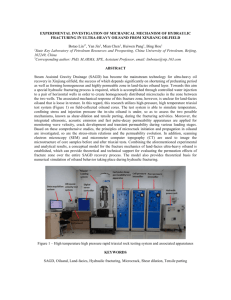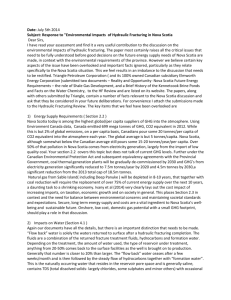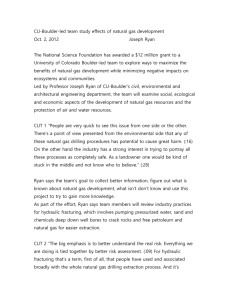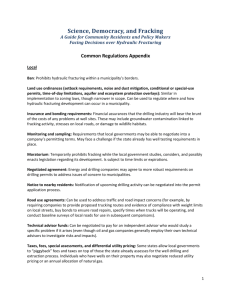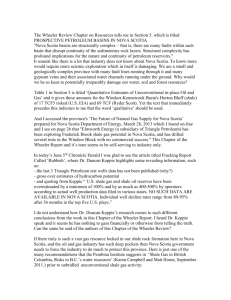Shale gas is neither an intermediate or long term solution to our
advertisement
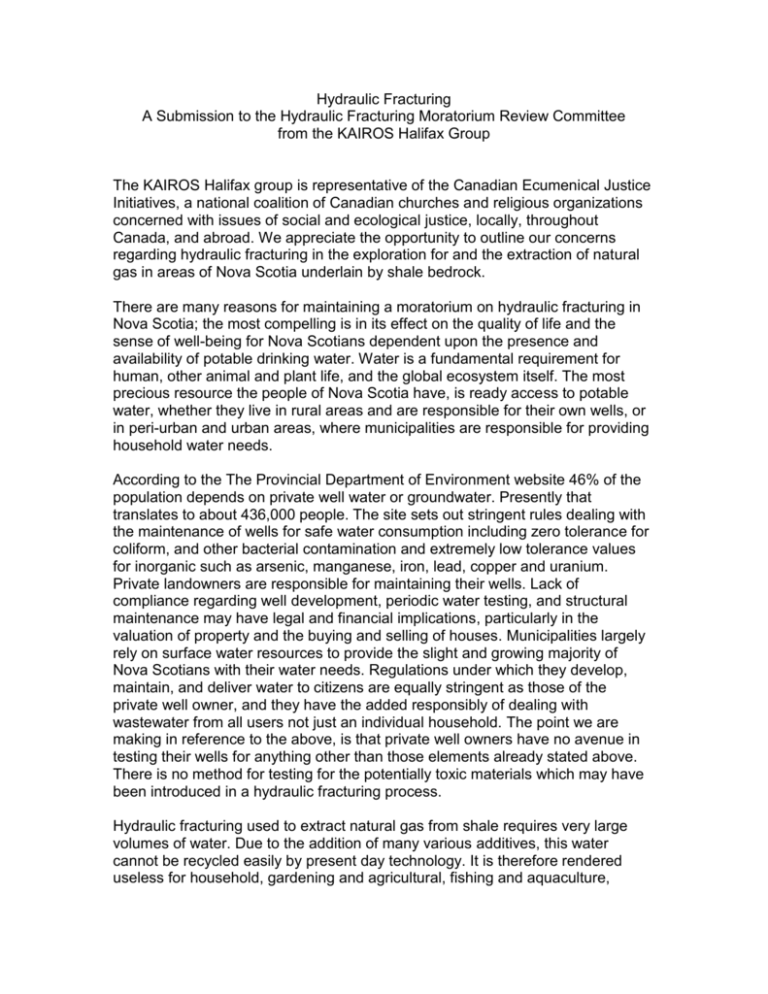
Hydraulic Fracturing A Submission to the Hydraulic Fracturing Moratorium Review Committee from the KAIROS Halifax Group The KAIROS Halifax group is representative of the Canadian Ecumenical Justice Initiatives, a national coalition of Canadian churches and religious organizations concerned with issues of social and ecological justice, locally, throughout Canada, and abroad. We appreciate the opportunity to outline our concerns regarding hydraulic fracturing in the exploration for and the extraction of natural gas in areas of Nova Scotia underlain by shale bedrock. There are many reasons for maintaining a moratorium on hydraulic fracturing in Nova Scotia; the most compelling is in its effect on the quality of life and the sense of well-being for Nova Scotians dependent upon the presence and availability of potable drinking water. Water is a fundamental requirement for human, other animal and plant life, and the global ecosystem itself. The most precious resource the people of Nova Scotia have, is ready access to potable water, whether they live in rural areas and are responsible for their own wells, or in peri-urban and urban areas, where municipalities are responsible for providing household water needs. According to the The Provincial Department of Environment website 46% of the population depends on private well water or groundwater. Presently that translates to about 436,000 people. The site sets out stringent rules dealing with the maintenance of wells for safe water consumption including zero tolerance for coliform, and other bacterial contamination and extremely low tolerance values for inorganic such as arsenic, manganese, iron, lead, copper and uranium. Private landowners are responsible for maintaining their wells. Lack of compliance regarding well development, periodic water testing, and structural maintenance may have legal and financial implications, particularly in the valuation of property and the buying and selling of houses. Municipalities largely rely on surface water resources to provide the slight and growing majority of Nova Scotians with their water needs. Regulations under which they develop, maintain, and deliver water to citizens are equally stringent as those of the private well owner, and they have the added responsibly of dealing with wastewater from all users not just an individual household. The point we are making in reference to the above, is that private well owners have no avenue in testing their wells for anything other than those elements already stated above. There is no method for testing for the potentially toxic materials which may have been introduced in a hydraulic fracturing process. Hydraulic fracturing used to extract natural gas from shale requires very large volumes of water. Due to the addition of many various additives, this water cannot be recycled easily by present day technology. It is therefore rendered useless for household, gardening and agricultural, fishing and aquaculture, 2 recreational, or industrial purposes having been combined with carcinogenic, mutagenic and/or toxic chemicals. Not all of the hydraulic fracturing fluid is recovered, but the large quantity that is, must be stored because it is too toxic to be treated as normal sewage. Much of the residual un-recovered hydraulic fracturing fluid remains within the well for as long as the well casing remains intact. However, well casings fail. The shale gas/oil industry itself records up to 6% casing failure in recent explorations, and as much as 60% over a period of 30 years. The implications of casing failure are fairly obvious, with back flow of contained water laced with both hydraulic fracture chemicals including radioactive elements together with those that may be naturally occurring. Studies of on-the-ground conditions affecting the health of local people and the ecology of the immediate vicinity, indicate spillage from back flow may contaminate both surface and ground water during the hydraulic fracturing operation, and corroded and/or broken pipes in old or abandoned sites can be responsible for seepage of fluids and gasses. This seeping of toxicity may happen over a very long time, and has the potential of contaminating existing potable water wells, and making new water well drilling pointless. Not only the water but also the immediate land area becomes contaminated and considered unusable for other purposes and termed derelict. Although groundwater resources have not yet been fully mapped in Nova Scotia, the relationship of underlying bedrock to potable water resources is well known, and it is fragile. Arsenic, a known carcinogenic element, is often present in bedrock and hence potentially in groundwater throughout the province. Already a health and environmental problem in the vicinity of former gold mine sites, its presence in both ground and surface could be exacerbated by hydraulic fracturing activity. The exploration and extraction of natural gas from shale bedrock raises a number of concerns for Nova Scotians. In spite of the positive pronouncements by the oil and gas industry and little questioning by the mainstream media, there is substantial evidence that hydraulic fracturing may disrupt and/or contaminate underground and surface water sources both during exploration or initial well development and in the long term. As Engineering Professor Tony Ingraffea of Cornell University told audiences in both Nova Scotia and New Brunswick in 2011, “The effects of fracking are cumulative…[Although] communities may not be seeing some of the consequences today, communities will see the effects of fracking in 10 or more years.” During the last decade hydraulic fracturing has resulted in a small number of productive natural gas wells in neighboring New Brunswick and a few exploratory wells drilled in Nova Scotia. Citizens of both provinces including First Nations, whose internationally recognized right to be consulted was ignored, have challenged the governments regarding their ability to regulate, manage and maintain oversight for a new industry that may have devastating effects on both our natural environment and ourselves. 3 The two wells drilled in the Kennetcock area (KC#1 and KC#2) in 2007 each took 7 million litres of water. This total of 14 million litres was drawn from the Kennetcook and Noel Rivers. No water gauge was in place and no monitoring of the withdrawal done. There is no record of how much sand was used, where sand was procured, or where sand returned to the surface, was disposed of. The normal admixture of chemicals and chemical products in fracking fluid is .5 - 2%. If 1% was used in Kennetcook then 70,000 litres of chemicals were sent down each of the two wells. No documentation is available on either the flowback to the surface, or how much of the hydraulic fracturing fluid is assumed to have remained underground. Hyraulic fracturing fluid contents are not fully listed but of the chemical and chemical compounds or products known to have been used in wells in Hants County: of 22 identified chemicals, 8 were potential carcinogens, 8 potential mutagens, 2 adversely affect reproduction, and 11 could cause adverse affects on ecological integrity; and, of 31 identified chemical compounds 8 contained potential carcinogens,10 were associated with adverse effects on animal reproduction or were potential mutagens, while 8 were known to cause potential adverse effects on ecological integrity. The development and the maintenance of water storage ponds associated with the two Kennetcook wells also leads to questions. The Department of Environment granted permission to build two ponds for fresh water storage. The ponds were used to store wastewater, but the application to do so was after the fact. Permission for wastewater use was granted for two years, and then extended for one. Pond edges have been breached; seepage from one berm is often noticeable. Overflow has occurred during rainy and heavy snow conditions, the wastewater remains onsite 7 years later. No listing of the contents, levels of contamination, including the presence of radioactive elements in the ponds has been made available, and no monitoring is apparent. The wastewater from the hydraulic fracturing operations did not all end up in the ponds, records note it was taken to other locations. An unknown amount was used in fracking the nearby Noel Lake well, and 4.5 million litres remains stored at Atlantic Industrial Services in Debert. 7.3 million litres was sent to and went through the Windsor municipal sewage facility and then into the Avon River. Over 5 million litres was approved to be put out on nearby ground while frozen and allowed to melt onsite, while 3.5 million litres was taken from one pond in 2008, its destination unrecorded. Some 11 million litres remain in the ponds. In view of the extremely poor safety aspects recorded above, will our elected politicians accept responsibility in protecting the people of Nova Scotia from the destructive environmental effects of hydraulic fracturing? Furthermore, will the N.S. Department of Environment develop a strong policy in water management, providing all Nova Scotians and future generations with the basic right of access to pure potable drinking water? Much of our concern stems from what is not known and hence appreciated about the fragility of the natural environment, particularly in the case of water when 4 used as a conduit carrying waste products of hydraulic fracturing. Neither dilution nor long term storage are environmentally feasible. 7.3 million litres of wastewater from Kennetcook was sent to the town of Windsor municipal sewage system, which was not set up to handle chemical heavy metals or radioactive materials. Indeed, at that time the wastewater had not been tested for either heavy metals or radioactive elements. When asked how this had happened, the then Minister of Environment said that the water had been analyzed by a consultant, who deemed it safe to be treated as sewage, and then added that the consultant was not aware of Nova Scotia’s geology. What is the illustration of stewardship of water resources we see here? The fragility of our Nova Scotia environment vis-a-vis the soil and underlying bedrock demands that we have in place regulations and laws within which mineral exploration companies abide. These regulations and laws require strict adherence and oversight by whatever Provincial Government agency is appointed to police such activity. Regulations, including the disclosure of the type and amounts of elements or compounds used in hydraulic fracturing cannot be ignored or rescinded for expediency. This would also include any type of mining or industrial activity where a large amount of water is used, there is contact with natural water sources, and/or production of industrial waste water. Does the experience Nova Scotians have had with international companies and their local subsidiaries suggest that hydraulic fracturing in the shale bedrock areas of Nova Scotia would be done with any more care than it is being done elsewhere in eastern North America? Wellheads from exploratory wells shot in northeastern New Brunswick last summer continue to seep, and at times chemically laced water from pools flows downslope. If they had been drilled in Nova Scotia would the situation be any different? If drilling in Lake Ainslie had gone ahead would wastewater or seepage be contaminating that water body? When will the internationally recognized First Nations right to be informed and consulted be honoured? We recommend that a moratorium be placed on hydraulic fracturing for hydrocarbon exploration and production in Nova Scotia. We ask that this moratorium, without exception, be in place for a minimum of 10 years and that serious consideration to make it a permanent ban is assessed during this time. Thank you. Written on behalf of KAIROS Halifax c/o Mary Rigby and R. Lindsay Rankin March 24, 2014

